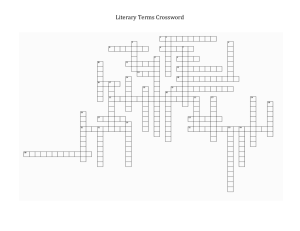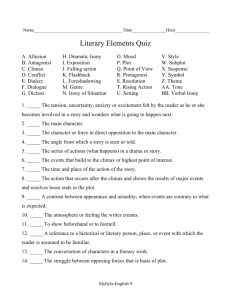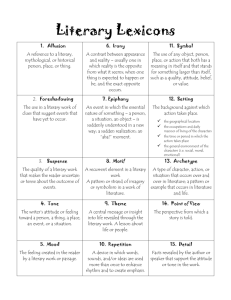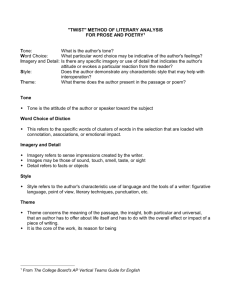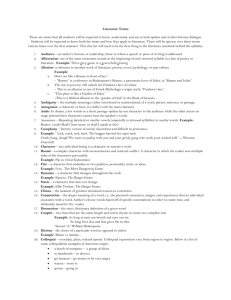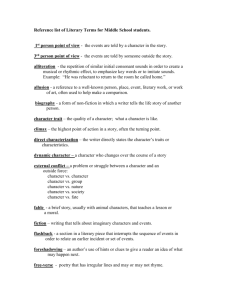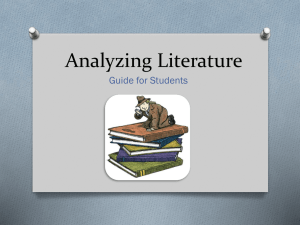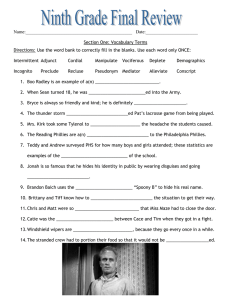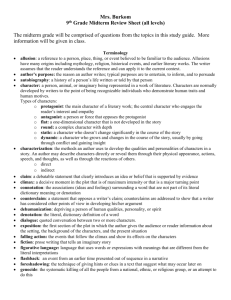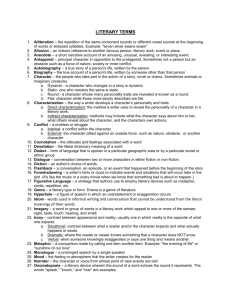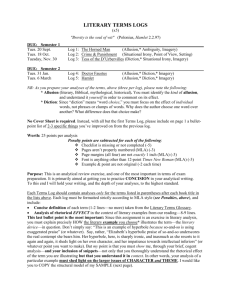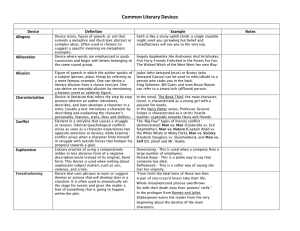Literary Terms to Know
advertisement
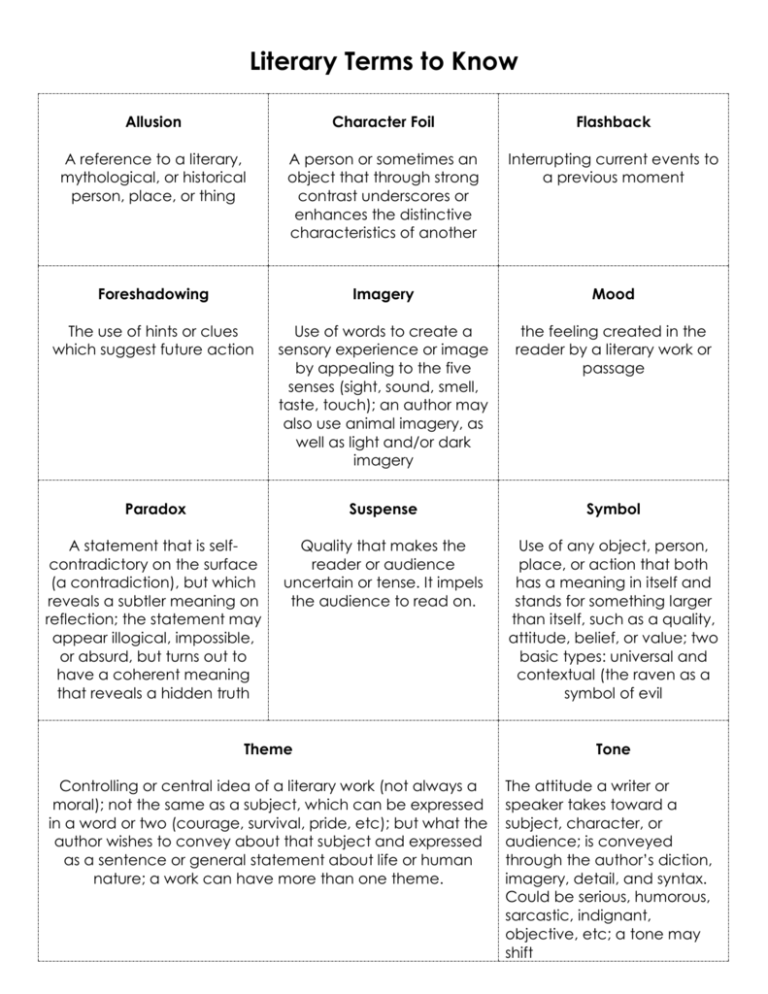
Literary Terms to Know Allusion Character Foil Flashback A reference to a literary, mythological, or historical person, place, or thing A person or sometimes an object that through strong contrast underscores or enhances the distinctive characteristics of another Interrupting current events to a previous moment Foreshadowing Imagery Mood The use of hints or clues which suggest future action Use of words to create a sensory experience or image by appealing to the five senses (sight, sound, smell, taste, touch); an author may also use animal imagery, as well as light and/or dark imagery the feeling created in the reader by a literary work or passage Paradox Suspense Symbol A statement that is selfcontradictory on the surface (a contradiction), but which reveals a subtler meaning on reflection; the statement may appear illogical, impossible, or absurd, but turns out to have a coherent meaning that reveals a hidden truth Quality that makes the reader or audience uncertain or tense. It impels the audience to read on. Use of any object, person, place, or action that both has a meaning in itself and stands for something larger than itself, such as a quality, attitude, belief, or value; two basic types: universal and contextual (the raven as a symbol of evil Theme Controlling or central idea of a literary work (not always a moral); not the same as a subject, which can be expressed in a word or two (courage, survival, pride, etc); but what the author wishes to convey about that subject and expressed as a sentence or general statement about life or human nature; a work can have more than one theme. Tone The attitude a writer or speaker takes toward a subject, character, or audience; is conveyed through the author’s diction, imagery, detail, and syntax. Could be serious, humorous, sarcastic, indignant, objective, etc; a tone may shift Emphasis When important aspects of a story are given important positions and in-depth development Emphasis is created by the use of: Repetition – reiteration of a word, sound, phrase, or idea Parallelism – the arrangement and repetition of words, phrases, or sentence structures using similar grammatical form. Parallelism adds rhythm and emotional impact to writing Irony Verbal Dramatic A deliberate contrast between two levels of meaning Implying a different meaning than what is directly stated. (ex. You call a tall teammate “tinny”) Audience knows something that one or more of the characters does not (ex. You know the girl should not go down to the dark, creepy basement because that is where the bad guy is, but she goes anyways) Situational A situation turns out differently from what one would normally expect, though the twist is oddly appropriate (ex. A deep sea diver drowning in a bathtub) Point of View (POV) First-person Second-person The identity of the narrative voice; the person or entity through whom the reader experiences the story Narrated by a character in the story or a direct observer Style which addresses the reader as you, hoping to make you identify with the character Third-person Omniscient Third-person Limited Objective Knows all about all the characters and is only limited by what she may want to tell you Describes a narrator who knows everything but only follows the point of new of one particular character The author does not presume to know the thoughts and feelings of the characters; the author simply reports what can be seen or heard Diction Denotation A writer’s or speaker’s choice of words which is intended to convey a certain effect; includes both vocabulary and syntax; can be formal or informal, technical or common, abstract or concrete The specific dictionary definition of a word Conflict A struggle/interplay between opposing forces Man vs. Self (internal) When a character must make a decision about a problem or struggle he is having within himself Connotation The feeling or attitude associated with a word, related to but quite distinct from its literal meaning Man vs. Man (external) When a character has a problem with another character Man vs. Nature (external) When a character has a problem with a force of nature Man vs. Society (external) When a character has a problem with a tradition or rule of society Man vs. Fate/Destiny (external) When a character has a problem with something he can’t do anything about (such as God, luck, death, etc) Characterization Motivation Protagonist The techniques used by the writer to create a character: The character’s physical appearance The character’s own speech, thoughts, actions, and/or feelings OTHER character’s speech, thoughts, actions, and/or feeling about the character Direct comments by the author about the character A reason that explains a character’s thoughts, feelings, actions, or behavior The central character and focus of interest who is trying to accomplish or overcome something or someone Dynamic Character Antagonist A character that undergoes a change in actions or beliefs The character or force which during the course of a story opposes the main character Static Character A character that does not grow or change throughout the story, that ends as s/he began Figurative Language Hyperbole A statement that is an Words or phrases that exaggeration to emphasize a describe one thing in terms of point and is used for something else; always expressive or comic effect involving some sort of comparison between seemingly unlike things; not meant to be taken literally Simile The comparison of two unlike things using the words “like” or “as”. (ex. My brother is as good as gold.) Metaphor Oxymoron Personification The direct comparison of two unlike things without using “like” or “as”. A metaphor wastes no time in getting to the point. (ex. My brother is a rat) Combining of opposites for emphasis. Examples: jumbo shrimp, deafening silence, wise fool When the author speaks of or describes an animal, object, or idea as if it were a person. (ex. The moon smiled down at me) Plot Exposition Setting The author lays the groundwork for the story by revealing the: setting, relationships between the characters, and situation as it exists before conflict begins The background against which action takes place. The action or sequence of events in a literary work. It is a series of related events that build upon one another. The geographical location The time or period in which the action takes place The general environment of the characters, i.e. social, moral, emotional. Then setting can set the mood as well. Rising Action Climax Falling Action The action and events that take place in the story leading up to the climax. Filled with complications and conflicts. The most critical moment in the story; the point at which the main conflict is at its highest point Events that occur after the climax and lead up to the closure of the story Denouement/Resolution The problem set up in the beginning is unraveled; there is a revelation of meaning.
